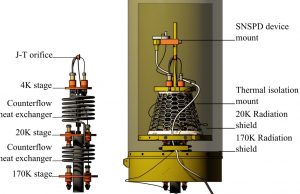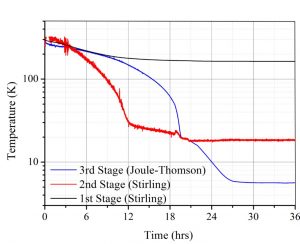[ad_1]
It uses a new form of cooling technology developed for space astronomy, but which could allow superconducting detectors to be used in cancer treatments, driverless cars and practical quantum communications.

Figure 1: schematic of cold finger mechanism alongside the cryostat design with new parts for SNSPD mounting added.
The research centres around extremely sensitive light sensors known as superconducting nanowire single photon detectors (SNSPDs), which are capable of detecting individual light quanta – photons – even at infrared wavelengths.
SNSPDs need to be cooled to a just few degrees above absolute zero (−273.15 °C) in order to work effectively – a process which requires expensive and hazardous liquid helium, or a great deal of electrical power to achieve.
The research team from Glasgow and Rutherford Appleton labs have developed a more portable, less power-hungry platform for SNSPDs which opens up a wide range of new applications for the technology.
Nathan Gemmell, of the University of Glasgow’s School of Engineering, is the lead author of the research, writes:
“We’ve adapted technology initially developed for the European Space Agency’s Planck mission, which launched in 2009 and successfully surveyed cosmic background radiation in the microwave and infrared frequencies of the spectrum over four and a half years in space.
“We’ve taken a fibre-optic coupled superconducting detector supplied by the Dutch start-up Single Quantum BV and housed it in a miniaturised cooler capable of reaching temperatures of 4.2 Kelvin, or -268.95 °C, which runs from standard mains power.”

Figure 2: typical cool-down plot for the three cold finger stages: 1st Stage (Stirling), 2nd Stage (Stirling) and 3rd Stage (Joule–Thomson).
Professor Robert Hadfield, Professor of Photonics at the University of Glasgow’s School of Engineering, and lead researcher on the project, writes:
“The research outlines how we’ve been able to use the SNSPD for infrared single-photon light detection and ranging, a form of distance measurement which could play a key role in the development of systems suitable for driverless cars in the future.
“In a cancer treatment called photodynamic therapy (PDT), the treatment drug exchanges energy with surrounding oxygen molecules on optical excitation, creating singlet oxygen radicals which kill tumour cells.
“A miniaturised cooling platform like ours would make SNSPD use in clinical PDT much more practical, potentially making cancer treatments more effective.”
The research titled: ‘A miniaturised 4 K platform for super-conducting infrared photon counting detectors’, is published in Superconductor Science and Technology.
The research was funded by the Engineering and Physical Sciences Research Council (EPSRC) through QuantIC, the UK quantum technology hub in quantum enhanced imaging and the European Research Council (ERC).
[ad_2]
Source link
